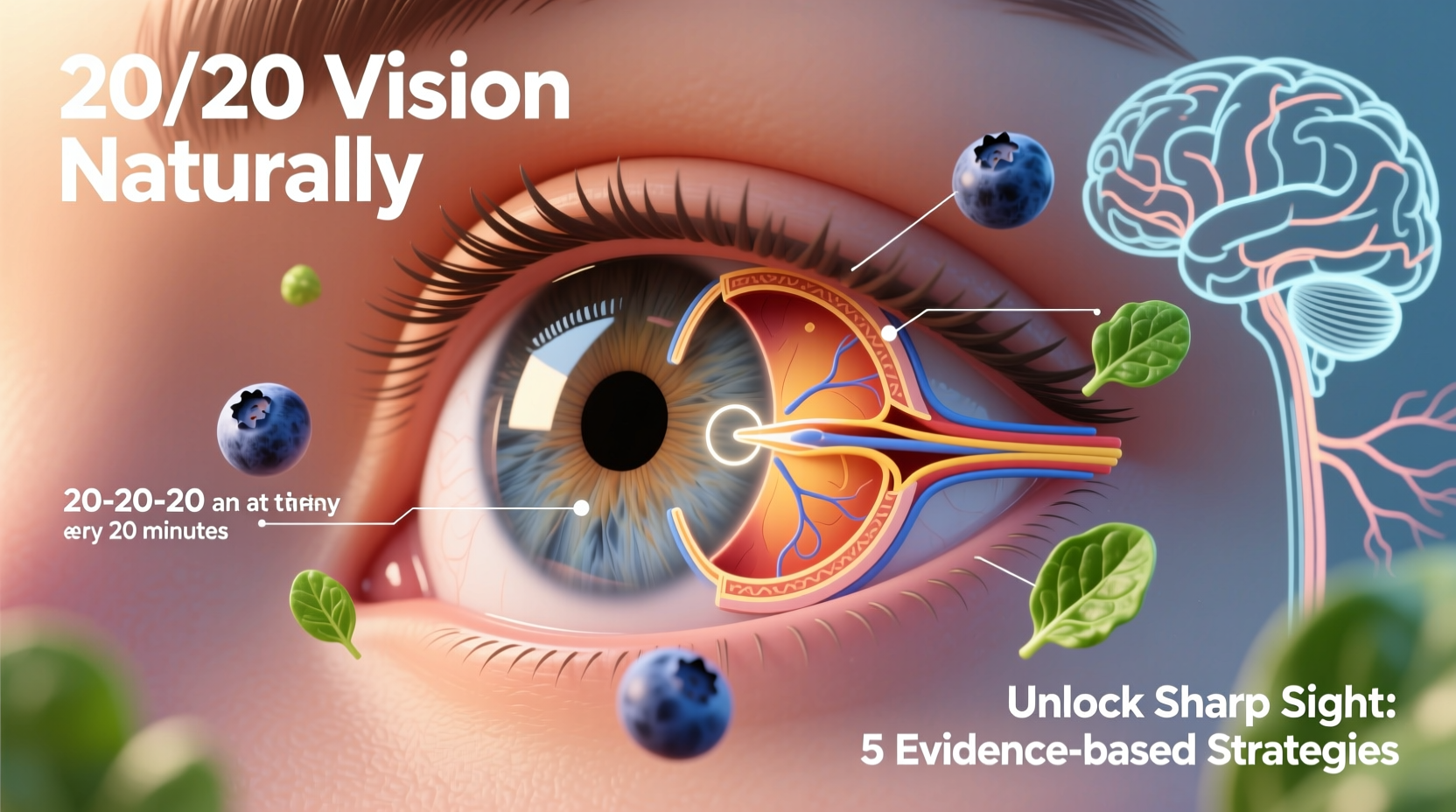Clear, sharp vision is more than a luxury—it’s a vital component of daily life. While corrective lenses and surgeries exist, many people seek natural ways to preserve or even enhance their visual acuity. Achieving and maintaining 20/20 vision isn’t solely dependent on genetics; lifestyle choices, diet, and consistent eye care play pivotal roles. With growing screen time and environmental stressors, proactive vision care has never been more important. The good news? You can support your eyes with practical, evidence-based strategies that promote long-term ocular health.
Nutrition: Fuel Your Eyes from the Inside Out

The eyes are metabolically active organs that require specific nutrients to function optimally. Antioxidants, essential fatty acids, and vitamins work synergistically to protect retinal cells, reduce oxidative stress, and maintain fluid balance in the eye.
Key nutrients for eye health include:
- Lutein and Zeaxanthin: Found in leafy greens like kale and spinach, these carotenoids accumulate in the macula and filter harmful blue light.
- Vitamin A: Essential for night vision and corneal integrity. Sources include sweet potatoes, carrots, and liver.
- Omega-3 Fatty Acids: Support tear production and reduce dry eye symptoms. Fatty fish like salmon and chia seeds are excellent sources.
- Vitamin C and E: Powerful antioxidants that help prevent cataract formation and slow age-related macular degeneration (AMD).
- Zinc: Helps transport vitamin A from the liver to the retina. Found in pumpkin seeds, legumes, and shellfish.
Eye Exercises: Strengthen Focus and Reduce Strain
Just as physical exercise strengthens muscles, targeted eye exercises can improve coordination, focus flexibility, and reduce strain—especially for those spending hours on digital screens.
Common exercises backed by optometric practice include:
- Palming: Rub hands together to generate warmth, then cup them over closed eyes without applying pressure. This promotes relaxation and reduces mental fatigue.
- Figure Eight Tracing: Visualize a large figure eight on the floor 10 feet away. Slowly trace it with your eyes for 2–3 minutes to improve smooth pursuit movements.
- Near-Far Focus Shifting: Hold a finger at arm’s length, focus on it, then shift focus to a distant object. Repeat 10 times to enhance accommodative ability.
- Blinking Drills: Consciously blink every 3–5 seconds for one minute to combat dryness caused by reduced blinking during screen use.
“Daily eye exercises may not reverse refractive errors, but they significantly reduce eye strain and improve functional vision.” — Dr. Alan Kim, Optometrist and Vision Therapist
Lifestyle Habits That Protect Vision
Your daily routines have a direct impact on eye health. Simple behavioral shifts can make a lasting difference.
| Habit | Benefit | Recommended Practice |
|---|---|---|
| 20-20-20 Rule | Reduces digital eye strain | Every 20 minutes, look at something 20 feet away for 20 seconds |
| Sunglasses Use | Blocks UV damage linked to cataracts and macular degeneration | Wear UV400-rated sunglasses outdoors, even on cloudy days |
| Adequate Sleep | Allows tear film restoration and ocular repair | 7–9 hours per night |
| Smoking Avoidance | Lowers risk of AMD and optic nerve damage | Quit smoking; avoid secondhand smoke |
Real Example: Maria’s Screen Fatigue Turnaround
Maria, a 34-year-old graphic designer, experienced chronic headaches and blurred vision after long workdays. She began implementing the 20-20-20 rule, added palming breaks, and adjusted her workstation lighting. Within three weeks, her eye strain decreased significantly, and she reported improved clarity and focus—even during extended design sessions. Her optometrist noted better tear film stability during her next exam.
Preventive Care and Monitoring
Natural vision improvement doesn’t mean avoiding professional care. In fact, regular check-ups are essential for early detection of conditions like glaucoma, diabetic retinopathy, and macular degeneration—many of which develop silently.
A comprehensive eye exam should include:
- Visual acuity testing
- Dilated fundus examination
- Intraocular pressure measurement
- Optical coherence tomography (OCT), if indicated
Step-by-Step Guide to Daily Vision Support
Follow this routine to integrate vision-friendly habits into your day:
- Morning: Start with hydration and a breakfast rich in omega-3s (e.g., walnuts, flaxseed) and dark leafy greens.
- Work Hours: Apply the 20-20-20 rule. Position your screen at arm’s length and slightly below eye level.
- Lunch Break: Take a walk outdoors—natural sunlight helps regulate circadian rhythms and supports eye development (especially in children).
- Afternoon: Perform a 3-minute palming session and blinking drill to reset tired eyes.
- Evening: Reduce blue light exposure using device filters or amber-tinted glasses two hours before bed.
- Before Bed: Reflect on any visual discomfort and note changes over time. Keep a simple log if managing a condition like dry eye.
Frequently Asked Questions
Can you naturally achieve 20/20 vision if you currently need glasses?
While natural methods won’t eliminate refractive errors like myopia or astigmatism in most cases, they can stabilize vision, reduce dependency on stronger prescriptions, and prevent further deterioration—especially when started early. Children with mild myopia may benefit significantly from outdoor time and reduced near-work strain.
Are eye exercises safe for everyone?
Yes, basic eye exercises are safe for most people. However, individuals with strabismus, advanced glaucoma, or recent eye surgery should consult an eye care provider before starting a regimen. Overexertion or improper technique can cause temporary strain.
How long does it take to see results from natural vision improvement?
Results vary. Some notice reduced eye fatigue within days of adopting the 20-20-20 rule. Nutritional improvements may take 8–12 weeks to show measurable effects on dryness or night vision. Long-term structural benefits unfold over months to years of consistent care.
Conclusion: See Clearly, Live Fully
True visual wellness goes beyond 20/20 acuity—it encompasses comfort, endurance, and resilience against modern stressors. By combining nutrient-dense eating, mindful screen habits, targeted exercises, and regular monitoring, you empower your eyes to perform at their best for decades. Vision is one of your most precious senses; treat it with the daily attention it deserves.









 浙公网安备
33010002000092号
浙公网安备
33010002000092号 浙B2-20120091-4
浙B2-20120091-4
Comments
No comments yet. Why don't you start the discussion?